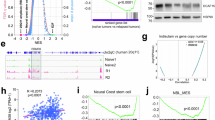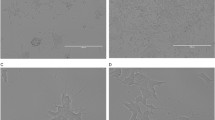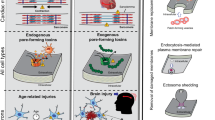Abstract
SERUM is required for the growth of nearly all animal cells in culture, but the mechanisms by which serum interacts with cells are largely unknown1,2. Evidence exists, however, that the primary site of action of the serum constituents is at the plasma membrane. For example, the first detectable events following serum stimulation of resting fibroblasts involve alterations in membrane transport, such as a stimulation of the (Na+ + K+)ATPase3,4 and an increase in the uptake of various nutrients5. Most of this evidence has been obtained using tracer flux techniques, but the relatively poor time resolution of this method (of the order of minutes) has precluded detection of dynamic membrane changes that may occur within seconds of serum addition. We have applied intracellular electrophysiological techniques in a search for rapid ionic membrane events following serum stimulation of mouse neuroblastoma cells. These cells stop growing (become ‘quiescent’) after serum removal and begin to extend neurites, but on re-addition of serum the neurites retract and cell division resumes6,7. Here we report that the immediate consequence of adding fetal calf serum (PCS) to quiescent neuroblastoma cells is a triphasic membrane potential response, caused by a series of transient ionic permeability changes, the first of which is a rapid and transient increase in Na+ conductance. These conductance changes, which are distinctly different from those underlying electrical excitability, seem to be the first events following serum stimulation and may provide a clue to the mode of action of serum growth factors.
This is a preview of subscription content, access via your institution
Access options
Subscribe to this journal
Receive 51 print issues and online access
$199.00 per year
only $3.90 per issue
Buy this article
- Purchase on SpringerLink
- Instant access to full article PDF
Prices may be subject to local taxes which are calculated during checkout
Similar content being viewed by others

References
Holley, R. W. Nature 258, 487–490 (1975).
Gospadarowicz, D. & Moran, J. S. A. Rev. Biochem. 45, 531–558 (1976).
Rozengurt, E. & Heppel, L. A. Proc. natn. Acad. Sci. U.S.A 72, 4492–4495 (1975).
Tupper, J. T., Zorgniotti, F. & Mills, B. J. cell. Physiol. 91, 429–440 (1977).
Baserga, R. Multiplication and Division in Mammalian Cells, 146–159 (Dekker, New York 1976).
Seeds, N. W., Gilman, A. G., Amano, T. & Nirenberg, M. W. Proc. natn. Acad. Sci. U.S.A. 66, 160–167 (1970).
Schubert, D., Humphreys, S., de Vitry, F. & Jacob, F. Devl Biol. 25, 514–546 (1971).
Amano, T., Richelson, E. & Nirenberg, M. Proc. natn. Acad. Sci. U.S.A. 69, 258–263 (1972).
Moolenaar, W. H. & Spector, I. Science 196, 331–333 (1977).
Moolenaar, W. H. & Spector, I. J. Physiol., Lond. 278, 265–286 (1978).
Kimhi, Y., Palfrey, C., Spector, I., Barak, Y. & Littauer, U.Z. Proc. natn. Acad. Sci. U.S.A. 73, 462–466 (1976).
Moolenaar, W. H. & Spector, I. J. Physiol., Lond. 292 (in the press).
Hülser, D. F. & Frank, W. Z. Naturforsch. 26 b, 1045–1048 (1971).
Steinhardt, R. H., Lundin, L. & Mazia, D. Proc. natn. Acad. Sci. U.S.A. 68, 2426–2430 (1971).
Smith, J. B. & Rozengurt, E. Proc. natn. Acad. Sci. U.S.A. 75, 5560–5564 (1978).
Author information
Authors and Affiliations
Rights and permissions
About this article
Cite this article
MOOLENAAR, W., DE LAAT, S. & VAN DER SAAG, P. Serum triggers a sequence of rapid ionic conductance changes in quiescent neuroblastoma cells. Nature 279, 721–723 (1979). https://doi.org/10.1038/279721a0
Received:
Accepted:
Issue date:
DOI: https://doi.org/10.1038/279721a0
This article is cited by
-
Calcium ions and the control of proliferation in normal and cancer cells
Bioscience Reports (1982)
-
Tissue culture in nephrology: Potential and limits for the study of renal disease
Klinische Wochenschrift (1980)


